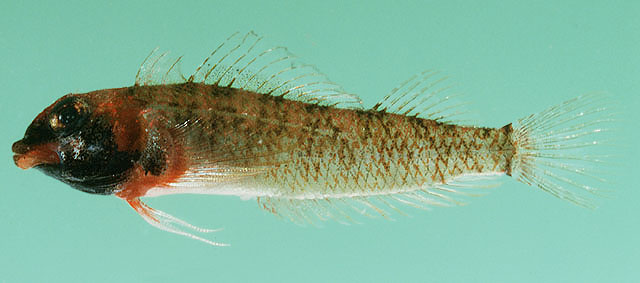| Tripterygiidae (Triplefin blennies), subfamily: Tripterygiinae |
| 4.5 cm SL (male/unsexed) |
|
reef-associated; marine; depth range 0 - 6 m, non-migratory |
| Southwest Pacific: Australia, New Caledonia (including the Loyalty Islands), Fiji, and Tonga. Records of this species from the Kermadec Islands (Ref. 8879) are based on Enneapterygius kermadecensis. |
|
Dorsal spines (total): 13-17; Dorsal soft rays (total): 8-12; Anal spines: 1-1; Anal soft rays: 16-21. Small supraorbital tentacle; first dorsal fin in females shorter by 50% than second dorsal fin; in males, shorter by 25%; body translucent gray in both sexes, edges of scales varying from pink to dark reddish brown, the pink-edged scales forming blotches along back; caudal fin base bearing a white bar; top of head red; female head brown and cheek with small white spots, red lower and posterior upper lip; lower part of male head black with exception of lower lip to end of maxilla being bright red and upper part of opercle red. Dorsal rays III + X-XIV + 8-12; lateral line interrupted, 15-20 + 15-21; mandibular pores 4 + 1 + 4 (Ref. 54980). |
| Adults are found in shallow water and tidal pools (Ref. 13227). They feed on gastropods (Ref. 94105). Eggs are hemispherical and covered with numerous sticky threads that anchor them in the algae on the nesting sites (Ref. 240). Larvae are planktonic which occur primarily in shallow, nearshore waters (Ref. 94114). |
|
Least Concern (LC); Date assessed: 03 May 2010 Ref. (130435)
|
| harmless |
Source and more info: www.fishbase.org. For personal, classroom, and other internal use only. Not for publication.

